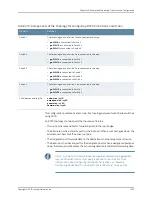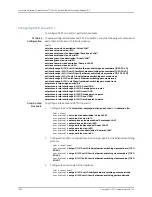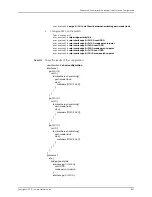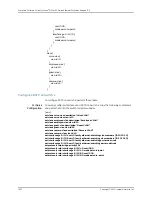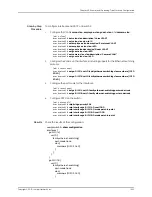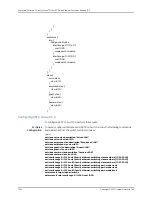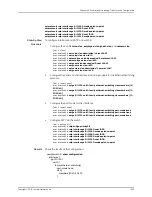
•
An
alternate port
, which provides an alternate root port.
•
A
backup port
, which provides an alternate designated port.
Port assignments change through messages exchanged throughout the domain. An
RSTP device generates configuration messages once per every hello time interval. If an
RSTP device does not receive a configuration message from its neighbor after an interval
of three hello times, it determines that the connection with the neighbor is lost. When a
root port
or a
designated port
fails on a device, the device generates a configuration
message with the proposal bit set. Once its neighbor device receives this message, it
verifies that this configuration message is better than the one saved for that port and
then it starts a
synchronizing
operation to ensure that all of its ports are in sync with the
new information.
Similar waves of proposal agreement handshake messages propagate toward the leaves
of the network, quickly restoring the connectivity after a topology change (in a
well-designed network that uses RSTP, network convergence can take as little as 0.5
seconds). If a device does not receive an agreement to a proposal message it has sent,
it returns to the original IEEE 802.D convention.
RSTP was originally defined in the IEEE 802.1w draft specification and later incorporated
into the IEEE 802.1D-2004 specification.
VSTP and RSTP can be configured concurrently. You can selectively configure up to 253
VLANs using VSTP; the remaining VLANs will be configured using RSTP. VSTP and RSTP
are the only spanning-tree protocols that can be configured concurrently on the switch.
Related
Documentation
Understanding STP for EX Series Switches on page 1519
•
•
Understanding MSTP for EX Series Switches on page 1521
•
Understanding VSTP for EX Series Switches on page 1525
•
Understanding Layer 2 Protocol Tunneling on EX Series Switches on page 1299
•
Example: Configuring Faster Convergence and Improving Network Stability with RSTP
on EX Series Switches on page 1527
Understanding MSTP for EX Series Switches
Although RSTP provides faster convergence time than STP, it still does not solve a
problem inherent in STP: All VLANs within a LAN must share the same spanning tree. To
solve this problem, Juniper Networks EX Series Ethernet Switches use Multiple Spanning
Tree Protocol (MSTP) to create a loop-free topology in networks with multiple
spanning-tree regions.
An MSTP region allows a group of bridges to be modeled as a single bridge. An MSTP
region contains multiple spanning tree instances (MSTIs). MSTIs provide different paths
for different VLANs. This functionality facilitates better load sharing across redundant
links.
MSTP region can support up to 64 MSTIs and each instance can support anywhere from
1 through 4094 vlans.
1521
Copyright © 2010, Juniper Networks, Inc.
Chapter 64: Spanning-Tree Protocols—Overview
Summary of Contents for JUNOS OS 10.3 - SOFTWARE
Page 325: ...CHAPTER 17 Operational Mode Commands for System Setup 229 Copyright 2010 Juniper Networks Inc ...
Page 1323: ...CHAPTER 56 Operational Mode Commands for Interfaces 1227 Copyright 2010 Juniper Networks Inc ...
Page 2841: ...CHAPTER 86 Operational Commands for 802 1X 2745 Copyright 2010 Juniper Networks Inc ...
Page 3367: ...CHAPTER 113 Operational Mode Commands for CoS 3271 Copyright 2010 Juniper Networks Inc ...
Page 3435: ...CHAPTER 120 Operational Mode Commands for PoE 3339 Copyright 2010 Juniper Networks Inc ...
Page 3529: ...CHAPTER 126 Operational Mode Commands for MPLS 3433 Copyright 2010 Juniper Networks Inc ...























